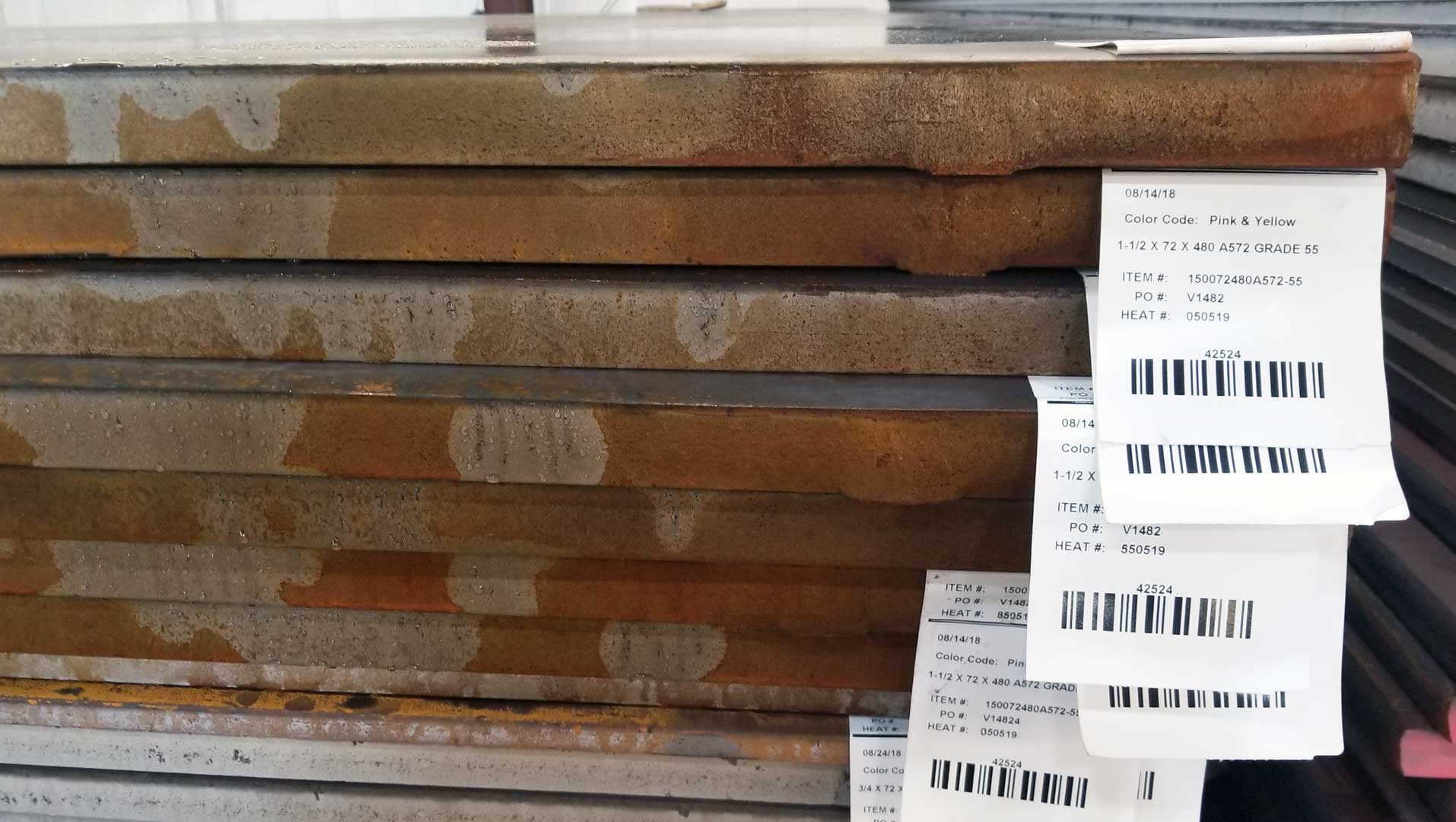We use cookies to analyze traffic and improve your experience. We may also share your information with our analytics partners to improve our website, as detailed in our Privacy Policy. You consent to our cookies if you continue to use this website.

The cost of steel plate and other steel materials is complex and fluctuating, as there are a number of factors that can impact price. This article has been updated as of April 2024 to reflect these factors.
Steel is typically priced by hundredweight (CWT), which is the price per 100 pounds of material. In some situations – such as materials market reports – carbon steel price may be reflected per-pound. For example, a CWT price of $40* is equal to $0.40 per pound.
To complicate pricing more, units are often quoted in tons, with 1 ton equaling 2,000 pounds.
So, for example:
2,000 pounds = 1 ton = $40 CWT x [2,000 pounds / 100 pounds]
1 ton = $800*
*The price used in this example is arbitrary and not based on current market levels.
Because steel plate is typically priced by CWT, understanding your order’s weight can be helpful in estimating costs. Factors such as thickness – or gauge – and size impact the material’s weight and, therefore, its cost. Use our calculator below to determine weight using height, width, thickness and quantity.
With this in mind, let’s move on to exploring factors that impact steel plate price. For a quick, condensed overview of these factors, view our "Cost of Steel Plate" infographic here. You can also ask us a question about steel plate products or pricing.
Steel is a basic raw material that is dictated by the laws of supply and demand, which results in an average market price. Excess supply leads to lower market prices, while limited supply drives market prices higher. For example, supply chain constraints caused lower supply and high demand, causing CWT to climb to historic highs. Supply has since stabilized but, due to rising demand and low inventories among service centers, prices have not yet returned to pre-surge levels.
In general, supply and demand are the most important factors in determining the price of steel at any given moment in time. These market prices change from day-to-day, and sometimes multiple times per day.
Day-to-day fluctuations in price are typically small, meaning it won’t greatly impact the cost of small-to-medium-sized projects. However, for large projects – let’s say a project that requires 10,000 tons of steel – a $1 increase in CWT would add $200,000 to the bill.
Let’s now explore the factors impacting daily steel prices.
Someone buying a car can expect to pay more for a top-of-the-line SUV than they would a compact economy vehicle.
The same is true with steel. Certain grades are inherently more expensive than others.

In general, the CWT increases as the steel grade becomes more specialized – either by adding alloys or using quenched and tempering processes to harden the material.
Below are general steel material categories, ranked from lowest-price to highest.**
**There are exceptions within each category. For example, A656 is a specialty High Strength Low Alloy grade, but is priced more in the range of Quenched & Tempered grades. Conversely, AR-Medium is an Abrasion Resistant grade, but its pricing is more in the range of Pressure Vessel Quality grades.
When soliciting quotes for a project, understand that certain grades will have a higher CWT than others. A full quote should list CWT for each grade. If it does not, it is certainly acceptable to ask. This can help you compare apples-to-apples between quotes.
As with anything, buying in bulk often lowers per unit costs. The same is true with steel.
When buying in bulk (which is roughly 22 tons or greater), suppliers can build time savings (such as speed and human resources) into CWT.
Additionally, bulk orders enable the supplier to buy in larger bulk from a mill manufacturer, which sees similar time-savings advantages that are passed on through their CWT.
Don’t have a bulk-quantity need? No problem.
Your needs over time can still impact CWT price. Someone who needs one piece of AR500 steel plate for a target practice backdrop has less future need than someone who requires one piece of AR500 per month for five years.
When submitting your project needs to a steel supplier, be sure to indicate future needs, even if buying in smaller quantities. This insight will help the supplier offer a more accurate quoted price on this and future orders.
The country of origin where the steel material is produced can play a large factor into overall CWT price. Some projects require specific countries of origin to meet quality requirements, but others can be more flexible about where the material originates.
Click here to learn more about the difference between foreign and domestic steel.
Look for suppliers who source from domestic as well as international mills. These suppliers are more likely to have a wider price range of steel material, giving you more options when you buy.
Requesting steel material that is cut, drilled or cleaned will likely add to overall cost, but may reduce CWT if the steel supplier can handle these requests in-house.
Related: Common Ways Steel Plate Is Processed
By bundling a material order with a processing request, suppliers may have more wiggle room with CWT. Be sure to mention any processing needs you may have with suppliers as you solicit quotes.
It is costly – in both time and dollars – to transport steel material due to size and weight. For this reason, quality steel suppliers have distribution centers in strategic cities across North America. This allows the supplier to deliver steel faster and more economically to customers across the continent.
A few suppliers build transportation cost into CWT, but most tack it on as an additional expense. When evaluating steel material quotes, be sure to understand how transportation will impact your total cost.
Occasionally, a steel supplier may have too much of a non-standard size or grade and will slash CWT in order to move the material (and clear warehouse space for more popular sizes and grades).
If a project has flexibility around a size and/or grade, it is certainly worth mentioning as you solicit quotes.

When sourcing steel materials, partnering with a niche supplier can save greatly on CWT. For example, Leeco® Steel specializes exclusively in supplying steel plate. Because this is our focus, we can be much more competitive on steel plate pricing than someone who supplies a more mixed variety of steel products (i.e. bars, coils and sheet).
However, sometimes your project requires more varied material types. In these cases, you should evaluate the time saved by working with a general “one-stop-shop” supplier and if it outweighs the CWT savings that can be offered by a niche supplier.
Whether you purchase prime steel plate or secondary steel plate can also determine material cost.
Prime steel plate meets regulatory or mill proprietary specifications for chemical and physical properties. This material is the bulk of what is sold by Leeco Steel and is priced at standard rates.
Secondary steel plate, also known as sub-prime plate, does not conform to regulatory specifications due to slight imperfections, such as not meeting flatness standards, having a poor surface or missing a mill test report. These imperfections make secondary steel plate less expensive than prime steel plate. Secondary steel plate is typically used in non-structural applications, including trash containers, roll-off containers and secondary pipe rollers.
When sourcing steel plate for your project, consider whether secondary plate could be an option for your application, or if your application requires prime plate.
Market regulation can greatly impact global and domestic CWT.
Tariffs placed on steel imports can make buying materials with non-domestic origins more expensive, thus resulting in greater demand for lower-priced domestic materials. Basic macroeconomics then take hold: greater demand lowers the supply and increases prices.
Governments will also sometimes subsidize domestic steel producers, allowing the material to be priced below what it actually costs to produce. This form of regulation can have a ripple effect and impact steel prices across the globe.
Whatever the regulation, it can have a major impact in CWT across the board.
Government bills and legislation passed can have a significant impact on steel plate demand.
The Inflation Reduction Act (IRA) and Infrastructure Investment & Jobs Act (IIJA) are two recent bills that provide billions in funding to sectors that extensively use steel products, such as wind and solar energy, manufacturing, roads and bridges.
As funds from these bills are dispersed in 2024, 2025 and beyond, demand for steel plate will increase, which could drive prices upwards if demand outpaces supply.
The cost and availability of raw materials used to produce steel can have a major influence on CWT price.
If the price of materials used to make steel – such as iron ore, pig iron or scrap metal – goes up, so does the cost to produce steel. Oftentimes, steel producers will pass these additional production costs to their buyers by increasing the material’s price.
The availability of raw materials also impacts steel production. If there is a shortage of a raw material used to make steel, production will slow and available supply will deplete, which could place upward pressure on steel plate prices.
The recent market shift towards steel decarbonization could also impact the type of raw materials used in steel production. As more steel mills produce carbon neutral steel – also known as “green steel” – use of electric arc furnaces (EAFs) and scrap metals is expected to increase. Additionally, many mills are aiming to use renewable energy sources in steel production rather than fossil fuels, and this change in energy source could also factor into production costs.
Unpredictable and unstoppable, natural disasters can be devastating. Communities find themselves needing to rebuild buildings, bridges, utilities and more. In the wake of natural disasters, demand for steel material needed for rebuilding can push prices temporarily higher across the market.
The COVID-19 pandemic, for example, disrupted supply and demand in 2020 and 2021. Demand for steel plate recovered at a much faster pace than supply, as many steel mills slowed production during the pandemic. This caused steel plate prices to rapidly rise as demand outpaced available supply.
Wars and conflicts can also disrupt the steel market through economic sanctions or supply chain and production constraints. A current example of this is the war between Ukraine and Russia. Ukraine and Russia are both major producers and exporters of raw materials used to make steel, so the conflict between the two countries impacted available steel supply in 2022. Many countries also enacted economic sanctions on Russia, which restricted steel imports of Russian material.
These instances are – thankfully – rare, but natural disasters and conflicts remain a significant factor in determining steel material price.
Despite touching on 13 factors that impact steel material pricing, this list is not exhaustive. However, armed with a better understanding of the major players in steel material pricing, you are better equipped to find the right steel material supplier for your project needs.
We encourage you to submit your projects that require steel plate material to Leeco Steel for quoting, as we offer some of the most competitive steel plate pricing in the U.S., Canada and Mexico. Use our simple quote builder tool or submit your list of requirements to Leeco Steel today.
Looking for a quote? We recommend you use our quote builder or submit a request for quote document via our RFQ Form.
Quote Builder Submit an RFQ